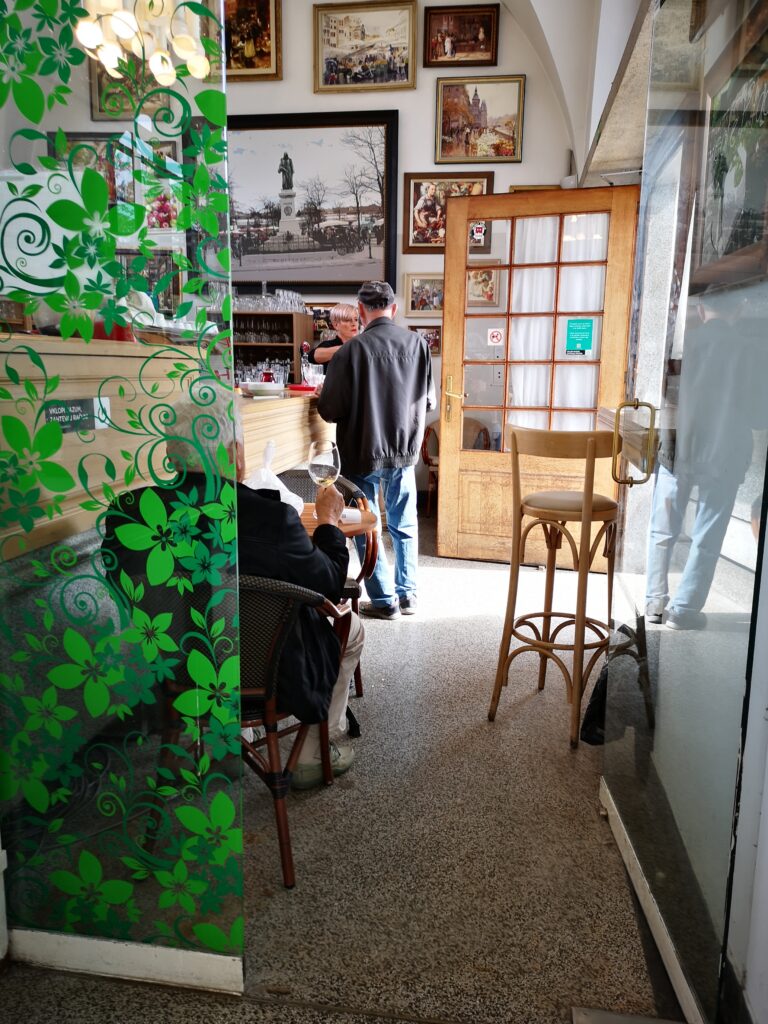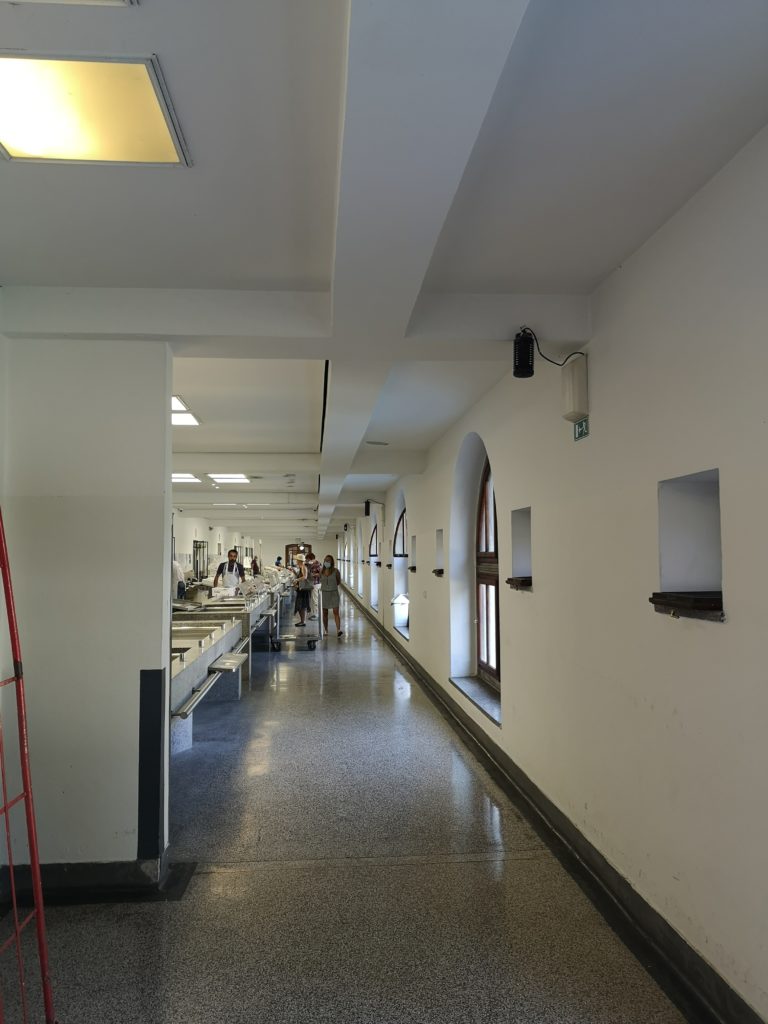This huge market is the place to start your visit to Ljubljana!

The Ljubljana market is at the heart of the Slovenian capital. It is at the foot of the castle. It takes place every morning until 1pm, from Monday to Saturday. This beautiful, lively place will give you a taste of the Slovenian soul. Here you can take part in the daily life of the people of Ljubljana.
In this article, you’ll discover all the secret corners of the Ljubljana market.
Most tourists only see one half of the market because they don’t know the little door that leads to the covered part and the hidden spiral staircase that takes you up to the fishmongers’ stalls. Here you’ll find precise directions to these secret places, as well as my favourite addresses, because like many of the capital’s inhabitants, I often do my shopping there.
You will also understand why the Ljubljana market is an exceptional architectural building, airy and highly original, designed, as is often the case in Ljubljana, by Plecnik.

What to do at the Ljubljana market?


Seek out the good produce from the market and farms

Drink a cappuccino at the market with the locals

Find the secret entrance to the covered market

Don’t miss the fishmongers’ and florists’ hidden entrances
Start at the large central square



This is where dozens of small producers from all over Slovenia sell their produce six days a week. As Slovenia enjoys a wide range of climates, you’ll find a variety of seasonal fruit and vegetables on their stalls. A profusion of local produce awaits the people of Ljubljana every day.
The best fruit often comes from the Slovenian coast or from Goriska Brda, a magnificent fruit and wine-growing region on the border with Italy.
You’ll see grandmothers selling their produce, or a market gardener carrying on the tradition of growing vegetables in the centre of Ljubljana, in the small central district of Krakovo, where I recommend you take a stroll. This market gardener makes the daily journey by handcart.

Be sure to try the cloudy apple juice (sold in 1.5-litre bottles) and stock up on fresh, local produce.
In autumn, try the delicious Slovenian persimmons. Softer than those sold in France, they can be eaten like jam. An autumn treat that I look forward to every year!


The word to know: Kmetija (farm)
You can find the small farms that sell their produce with the merchants who indicate Kmetja on their stalls and address.
Go through the small door of the covered market




The entrance to the covered market is a small door that 90% of tourists can’t find. Put the bridge with the padlocks behind you and look to the right. Go through the swing door under the Pokrita sign in black letters.
You’ll enter a hall full of butchers, pork butchers and creameries.
- Under these arcades, you’ll also find a shop selling fine Italian products (Italy is very close to Ljubljana).
- You’ll also find dried fruit and a baker who makes wholemeal bread.
- In this area, I always buy chicken from Hudin, but it’s only open on Saturdays. Delicious once cooked, it is served by two very efficient old ladies.
- Also try the pumpkin seed oil on offer at some of the stalls (in my opinion, it’s one of the best souvenirs you can bring back from Slovenia).
- Take your time wandering through all the passageways, as they are strangely oriented and you’re bound to miss one or two.
Explore the large market under the arcades

Rather than build a large market hall as was done throughout Europe, the brilliant architect Plecnik (1872-1957) had the original idea of building a long market, a slender, rhythmic and open building that stretches from the capital’s central square (the Place des Trois Ponts) to the famous Dragon Bridge. If architecture isn’t your cup of tea, skip straight to the section on fishmongers.
The Ljubljana market is an architectural complex 300 meter long.

As usual, Plecnik incorporated elements of classical architecture into the plans for his huge market. At the entrance to the market, you’ll see a small Palladian temple that was once a flower shop. In the middle of the market, you will now find a large bridge where lovers have hung thousands of padlocks, the Butchers’ Bridge (Mesarski most). From the outset, Plecnik envisaged this bridge as an integral part of the market, but it could not be built because of the Second World War. A mistake that has recently been rectified.

What to see: If you look closely at the details of the Plecnik market, you’ll see that the municipality didn’t spend a fortune on the construction of this beautiful market.

Work on building the market began during the Second World War, in 1940, and due to a lack of manpower and materials, it took several years to complete. Construction of the Ljubljana market was not completed until 1944. Plecnik was a genius at building cheaply. It is one of his major works in Ljubljana (along with the National and University Library, built in 1941). From an architectural point of view, the market works very well with the Three bridges Square, even though the two buildings were built ten years apart.

Now walk along the beautiful arcades designed by Plecnik. You will pass a good thirty food shops. They sell bread, meat, pastries, cheese, dried fruit and pumpkin seed oil. You’ll also find small restaurants where you can grab a bite to eat, and cafés where Ljubljana’s pensioners like to meet up to start their day… Here, you’ll have to push open the doors of the shops, as it’s not always easy to see what’s behind them. Sometimes you can walk from one shop to the next along the inner corridor, but sometimes you can’t – you have to go out again. Take your time exploring this picturesque part of the market.
Stop by the florists too

They are in a small alley between the covered market and the cathedral, which you should find easily enough. Arrangements of dried flowers can be an excellent souvenir to bring back from Slovenia.
Don’t pass by the clothes corner



This little clothing corner is not very interesting. No Made in Slovenia. Don’t waste your time here.
Don’t miss the secret fishmongers’ corner


To understand how Plecnik designed his market, you need to visit this lower part, which takes advantage of the coolness of the river. The fishmongers’ stalls are in the shade, facing north and down to be cooled by the Ljubljanica. Go down the small spiral staircase and walk through the entire fish market. As soon as you set foot on the first step, you’ll smell the fish – you’ve been warned!
Just after the fishmongers, you’ll come across an interesting gallery that tourists don’t find. Take a look at the works of art on the walls and in the little alcoves.


Make a detour to the Ribca fish restaurant, where you can take a beautiful photo of the central square and the Franciscan church, playing with the rounded shapes of the arcades. A nice cool place to enjoy a drink on a hot day. (Closed 2024-2025)
Have your morning coffee at the market

I like to have a coffee in the morning right next to the market to enjoy its gentle bustle.

You can sit on the terrace of the hipster café Magda , just a few metres from the stalls, or on one of the many other terraces for a €2.30 cappuccino. It’s a great way to start a day’s holiday with the locals, Italian-style dolce vita. You can also return to the market area for lunch: many restaurants serve simple dishes on the terrace for Slovenians who work in companies in the city.
The corner of wooden objects


In the upper part of the market, you’ll find wooden and straw items made in Slovenia. Take a look around and you might find some lovely souvenirs.
Saturday morning, the best day for a visit


As you may have read elsewhere on this site, in small Slovenian towns, the shops in the centre close on Saturday afternoons, but Saturday mornings are traditionally a busy time in town. Many Ljubljaners go to the market to do their shopping for the week and, as everywhere else, for the pleasure of bumping into friends and acquaintances.
On Saturdays, the stalls are better stocked than during the rest of the week and the vendors are at least twice as numerous.

If you can, plan your visit to the market for a Saturday, and if you’re spending several days in Ljubljana , as I recommend, visit on the first day of your arrival and come back to have a look at the market on Saturday morning. Do almost all your holiday food shopping there!
Look for the little hidden products

If you have a good eye, you’ll see that many producers have very small quantities of products on their stalls. So look carefully at the market stalls, ask questions… In short, rummage through the stalls, look for these products in very small quantities and look out for the jars. These are often the best products.
Dried apples

One of the most interesting Slovenian specialities is dried apples. You’ll find them in the covered part of the market. They’re an excellent snack for your hikes.
A super tip: the market’s apple juice dispenser

In the vending machine at the Ljubljana market, you’ll find this delicious, fresh and cloudy mama Jabolcnik apple juice for €1.50. Try it on a hot summer’s day. You’ll also find yoghurts and cheese.
Next door, Mlekomat, another vending machine, distributes fresh milk from farms around Ljubljana. If, as I recommend, you have booked accommodation in the centre of Ljubljana, this is the place to go to buy your milk.
Persimmons in October and November

If you come to Slovenia in October or November, don’t miss the delicious persimmons that come from the Slovenian coast and the Vipava valley. They are very soft and taste like jam. Delicious but fragile.
Things to remember about your visit to the market
- The market is a must on any trip to Ljubljana,
- It’s the place to go shopping,
- If possible, come on a Saturday morning
- It closes at 1pm for the central part and 2pm for fruit and vegetables
- The central part is hidden and you need to know the entrance
- You can come for lunch or a delicious morning coffee.
At the end of the market, don’t miss the Dragon Bridge


The Dragon Bridge (Zmajski most) is one of the most emblematic monuments in the Slovenian capital. This historic bridge, which spans the river Ljubljanica, is famous for its four imposing dragon statues. It is the symbol of the city. Built between 1900 and 1901, it is in the Art Nouveau style and was an engineering feat at the time due to its use of reinforced concrete, a technique that was still innovative.
